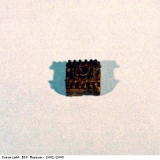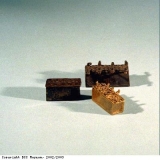African trade networks
African gold and other goods reached Europe long before European traders reached Africa. From about AD 650 African goods made their way to Europe through the trade between West Africa and North Africa. The Muslim ‘Moorish’ empire spread from North Africa to southern Europe. Goods bought from the West African traders by the North African Muslim traders were taken into southern Europe. Here they might then have been sold on to Europeans.
From about the 7th century AD, sophisticated trade networks were established. The map pictured here shows some of the trade routes used. These routes, along with the systems of money which developed, allowed the exchange of goods across Africa. The communities of West Africa were involved in an important trade route northwards. Travelling across the Sahara desert, the Muslim traders of North Africa dealt with the West Africans. The West Africans exchanged their local products like gold, ivory, salt and cloth, for North African goods such as horses, books, swords and chain mail. This trade (called the trans-Saharan trade because it crossed the Sahara desert) also included slaves. The slaves, usually captured as prisoners of war, were sold by the West Africans to the Muslim traders who came from North Africa. North Africa and parts of southern Europe were part of the Muslim ‘Moorish’ empire. Slaves would be taken to southern Spain as household servants. This was a trade that was active by the 7th century AD, and continued for centuries.
Trading goods for other goods, called bartering, was common all over Africa, but the West African peoples also had a type of money that they used in trade. Gold dust was the ‘money’ used in areas of West Africa and with North African traders. The Akan people, of what is today Ghana and Ivory Coast, mined gold and used it for trade both locally and internationally. Anyone using gold dust as money needed a set of equipment. They used boxes and bags to hold the gold dust, scales and weights to weigh it, spoons to transfer gold from box to scales, and brushes to clean the last speck off spoons and scales. Boxes for containing gold dust are pictured here. Some weights were square, round or triangular and decorated with geometric patterns. These came in sets of different weights, and are similar to those used by Muslim traders in North Africa. West African traders probably adopted it after contact with them. Some geometric weights are pictured here. Other weights were ‘figurative’ and made in many different shapes, such as people, animals, birds and guns. These weights often carried a message with the payment, based on African sayings.





